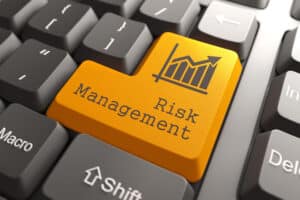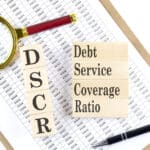In the world of business and finance, risk management and financial ratios go hand-in-hand.
One such vital financial ratio is the Debt Service Coverage Ratio (DSCR), an important tool for both lenders and borrowers alike to assess a company’s ability to service its debt.
On the other hand, risk management is a strategic process to identify, evaluate, and prioritize uncertainties in business operations and devise strategies to mitigate their impact.
Together, DSCR and risk management play a significant role in shaping a business’s financial health and future.
Understanding the nuances of a DSCR loan and how it plays into risk management can provide valuable insights into a company’s financial stability. It allows businesses and lenders to mitigate risks associated with credit and insolvency.
This article aims to shed light on the intricate relationship between DSCR and risk management.
Understanding DSCR
Debt Service Coverage Ratio (DSCR), or simply debt coverage ratio, is a financial ratio that measures a company’s ability to cover its debt obligations using its operating income.
The formula for calculating DSCR is:
DSCR = Net Operating Income / Total Debt Service
In this equation, the Net Operating Income (NOI) is the income from the business operations, excluding taxes and interest payments, while the Total Debt Service refers to the current debt obligations, including both principal and interest payments.
The resulting ratio gives a snapshot of a company’s financial health. A DSCR of 1.0 indicates that the company’s operating income is just enough to cover its debt obligations.
A ratio above 1.0 means the company has enough income to pay its debts and still have a surplus. Conversely, a ratio below 1.0 signals potential difficulties in meeting debt obligations, increasing the risk of default.
DSCR holds significant value in assessing financial risks. Businesses with a high DSCR are seen as less risky as they generate enough income to comfortably cover their debts.
Lenders are more likely to extend credit to such businesses, and they often enjoy lower interest rates and more favorable loan terms.
Understanding and actively managing DSCR can therefore play a pivotal role in a company’s risk management strategy.
DSCR as a Risk Management Tool
 Financial risk management is a crucial aspect of any business strategy.
Financial risk management is a crucial aspect of any business strategy.
It involves understanding and mitigating the various financial risks a business could face, such as credit risk, liquidity risk, and operational risk. Here’s where DSCR steps in as a pivotal risk management tool.
DSCR primarily serves as a measure of a business’s credit risk—the risk that a business may fail to meet its debt obligations.
A high DSCR indicates that a business has a substantial buffer of operating income over and above its debt repayments, making it less likely to default on its loans.
In contrast, a low DSCR suggests that a business is barely covering its debt obligations, increasing the likelihood of a financial shortfall and, consequently, the risk of default.
By maintaining a close watch on DSCR, businesses can assess and manage their credit risk effectively.
A decreasing DSCR could be a warning sign to take corrective actions, such as reducing costs, restructuring debt, or increasing income, to ensure that the business remains able to meet its debt obligations.
Furthermore, DSCR can also play a role in managing operational and liquidity risks.
For instance, a business with a high DSCR has a larger pool of income to dip into during unexpected events or economic downturns, thereby reducing its operational risk.
Similarly, a good DSCR indicates robust cash flow, which in turn, suggests a lower liquidity risk, meaning the business is less likely to run into issues fulfilling short-term obligations.
The Relationship Between DSCR and a Business’s Financial Stability
The relationship between DSCR and a business’s financial stability is direct and proportional. A high DSCR indicates strong financial stability, as it shows that the business generates sufficient income to cover its debt obligations with room to spare.
This surplus income can be reinvested back into the business, saved for unexpected expenses, or used to pay down debt more quickly, further bolstering the business’s financial stability.
In contrast, a low DSCR indicates potential financial instability. If a business’s operating income is barely covering its debt payments, there may be little to no surplus income available for unexpected expenses, reinvestment, or accelerated debt repayment.
In this situation, even a minor disruption to income or a slight increase in expenses could push the business into financial distress.
In essence, DSCR is not just a measure of a business’s ability to service its debt; it’s a key indicator of the overall financial stability of the business.
Therefore, it’s a critical tool in the arsenal of financial risk management.
Importance of DSCR in Lending Decisions
Lenders, particularly banks and other financial institutions, rely heavily on DSCR when making lending decisions.
It serves as a critical tool for them to assess a borrower’s ability to repay a loan, thereby minimizing their exposure to lending risk – the risk of the borrower defaulting on their loan repayments.
The role of DSCR in a lender’s decision-making process is multifold:
- Firstly, a high DSCR is often a prerequisite for loan approval. Lenders typically have a minimum DSCR requirement, usually above 1.0, to ensure the borrower generates enough income to service their debt.
- Secondly, DSCR influences the terms of the loan, such as interest rates and repayment periods. A borrower with a high DSCR is seen as less risky, which often results in more favorable loan terms, including lower interest rates and longer repayment periods. Conversely, a borrower with a low DSCR may be deemed high risk, leading to higher interest rates or stricter loan terms.
Understanding lending risk and its correlation with DSCR is essential for both lenders and borrowers.
- For lenders, it helps in risk mitigation and deciding loan terms.
- For borrowers, understanding this concept helps them strategize their financing options and work towards improving their DSCR, if needed, before applying for a loan.
DSCR Risk Management Strategies
 Implementing effective DSCR risk management strategies is crucial to maintaining a healthy DSCR and mitigating financial risk. Here are some strategies that businesses can use:
Implementing effective DSCR risk management strategies is crucial to maintaining a healthy DSCR and mitigating financial risk. Here are some strategies that businesses can use:
Increase Income
This strategy centers around improving the cash inflows of the business, thereby increasing the Net Operating Income (NOI), that contributes to a healthier DSCR. It could involve:
- Raising Prices: While it’s crucial to ensure price hikes don’t deter customers, a modest increase can significantly boost the revenue without impacting the demand, especially if the business has strong value propositions or is operating in a less price-sensitive market.
- Expanding Operations: This could mean opening new stores, launching new products, or entering new markets. Each of these actions can lead to higher sales and subsequently, a higher NOI.
- Improving Sales Strategies: From investing in marketing efforts to optimizing the sales funnel, numerous sales strategies can help increase revenue. Moreover, cross-selling and upselling to existing customers can also contribute to income augmentation.
Reduce Expenses
The other side of the coin is managing the cash outflows, i.e., the operating expenses. By reducing these, the NOI increases, contributing to a better DSCR. Some ways to do this include:
- Renegotiating Supplier Contracts: Businesses can work with their suppliers to negotiate better deals, either by leveraging economies of scale, long-term partnerships, or bulk orders.
- Minimizing Wastage: By identifying and minimizing inefficiencies and wastages in the business operations, firms can save substantial amounts. This could range from reducing energy consumption to optimizing the inventory turnover.
- Adopting Energy-Efficient Practices: With growing emphasis on sustainability, adopting energy-efficient practices not only reduces expenses but also enhances the company’s reputation.
Restructure Debt
The structure of a business’s debt heavily influences its DSCR. Therefore, restructuring debt can improve DSCR, such as:
- Consolidation of Debts: Businesses can consolidate several loans into one loan. If the consolidated loan has a lower overall interest rate, this reduces the total debt service and improves the DSCR.
- Extending the Loan Term: By extending the loan term, the annual debt service reduces, thereby improving the DSCR. However, businesses should consider this strategy carefully as it may lead to higher total interest payments over the life of the loan.
Maintain Financial Reserves
Building and maintaining financial reserves is a sound risk management strategy. It’s akin to having an emergency fund that can help your business navigate unanticipated financial hiccups and market downturns.
Here’s a closer look:
- Buffer Against Uncertainties: Financial reserves act as a safety net that can absorb unexpected operational costs, fluctuations in income, or unforeseen market events without affecting your DSCR. By having a backup, you can avoid scrambling for external funds that could potentially lower your DSCR.
- Building Trust with Lenders: A business that systematically maintains financial reserves demonstrates financial discipline and foresight. Lenders look favorably on this as it indicates that the business is more likely to meet its debt obligations even during tough times, thereby reducing the lender’s risk.
- Ensuring Smooth Operations: Having financial reserves can also allow businesses to continue operations during a cash crunch without resorting to further borrowing. This could involve paying salaries, purchasing raw materials, or meeting other operational costs.
Regular Monitoring
Regular monitoring and analysis of your DSCR can act as an early warning system for potential financial issues. Here’s why this is important:
- Spotting Trends: Regularly tracking your DSCR can help you identify patterns or trends in your business’s financial health. For instance, a gradually decreasing DSCR may point to rising costs, decreasing income, or increasing debt, allowing you to intervene and rectify the issue before it becomes critical.
- Making Informed Decisions: With continuous monitoring of DSCR, businesses have the data they need to make well-informed financial decisions. It can guide businesses in deciding whether to take on additional debt, invest in new opportunities, or revise financial strategies.
- Preventing Financial Risks: Regular monitoring of DSCR can help prevent financial risks such as defaulting on loans or bankruptcy. By keeping a close eye on DSCR, businesses can spot potential risks and implement preventive measures, ensuring the maintenance of a healthy DSCR.
- Improving Reporting and Forecasting: Regularly monitoring DSCR also aids in better financial reporting and forecasting. Understanding the trend of your DSCR can help in making accurate financial forecasts and developing financial strategies.
The Role of DSCR in an Overall Risk Management Plan
 Risk management is a comprehensive, holistic process. It involves managing various aspects of risk – from operational to credit, from market to liquidity.
Risk management is a comprehensive, holistic process. It involves managing various aspects of risk – from operational to credit, from market to liquidity.
Amidst all these facets, DSCR holds a central place in the overall risk management plan for a business.
Primarily, DSCR helps manage credit risk by providing insights into a business’s capacity to service its debt. Businesses can strategize around their DSCR to ensure they stay attractive to lenders and can secure funding when needed.
Simultaneously, a robust DSCR can also help businesses cushion against operational and liquidity risks, providing them with the financial resilience to weather unexpected downturns.
But the role of DSCR isn’t just restricted to managing financial risks. Its implications go beyond that, influencing various aspects of a business’s overall risk management strategy.
For instance, a good DSCR can enhance a business’s reputation among lenders and investors, opening up more opportunities for growth. It can also influence the business’s strategic decisions about growth, expansion, and investments.
Maintaining a strong DSCR, therefore, doesn’t just help businesses reduce their financial risks. It contributes to the business’s overall risk management efforts, fostering stability and resilience throughout the organization.
Final Thoughts
The Debt Service Coverage Ratio, or DSCR, plays a significant role in risk management, primarily mitigating financial risks. It provides critical insights into a business’s ability to service its debts, influencing both lenders decisions and the business’s overall financial stability.
However, as with any financial ratio, DSCR is not a standalone indicator. It must be used in conjunction with other financial metrics and viewed in the context of the overall business environment.
A proactive approach to managing DSCR, which involves regular monitoring, strategic income and expense management, and responsible debt handling – can significantly contribute to the financial health of a business.
DSCR isn’t just about securing loans or pleasing lenders. It’s about steering the business toward financial stability and sustainable growth.
By understanding the importance of DSCR and integrating it into their overall risk management strategy, businesses can make informed, strategic decisions that spur their growth and success.
Now that you have understood the profound influence of DSCR and risk management on your business’s financial health, it’s time to put this knowledge into action.
At Sprint Funding, we specialize in offering tailored financial solutions and risk management strategies, designed to secure and enhance your investment portfolio.
If you’re ready to start your journey towards financial stability and sustainable growth, our expert team is here to guide you every step of the way.
Contact us today to discuss your needs and learn how we can help shape your financial future.





